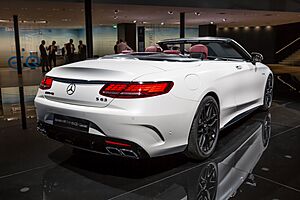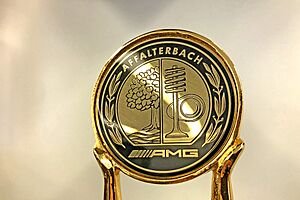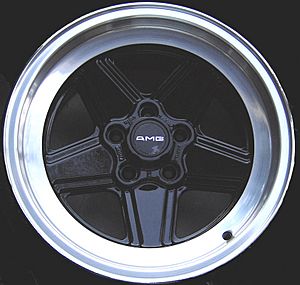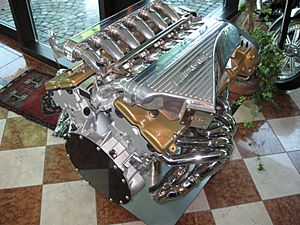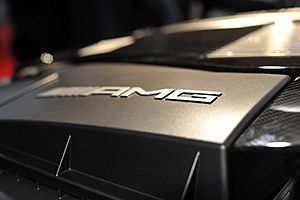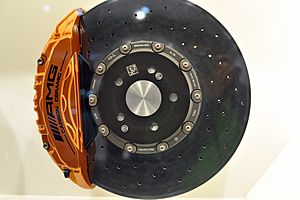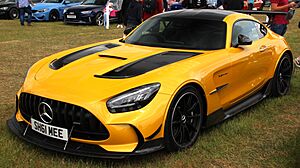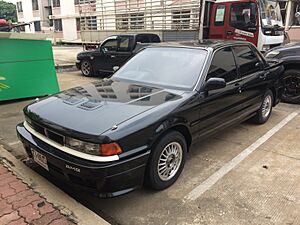Mercedes-AMG facts for kids
| Subsidiary (GmbH) | |
| Industry | Automotive |
| Fate | Acquired by DaimlerChrysler (1999), and operating under Daimler AG |
| Founded | 1967 (as AMG Motorenbau und Entwicklungsgesellschaft mbH) Burgstall a. d. Murr, Germany |
| Founders | Hans Werner Aufrecht Erhard Melcher |
| Headquarters |
Affalterbach
,
Germany
|
|
Area served
|
Worldwide |
|
Key people
|
Philipp Schiemer (Chairman of the Board) |
| Products | High performance automobiles |
| Services | Research and development |
|
Number of employees
|
~2,900 |
| Parent | Mercedes-Benz AG |
Mercedes-AMG GmbH, usually called AMG, is a special part of Mercedes-Benz AG. It focuses on making high-performance cars. AMG hires its own engineers and works with manufacturers to create unique Mercedes-Benz AMG vehicles. The company's main office is in Affalterbach, Germany.
AMG started as an independent company. It specialized in making Mercedes-Benz cars faster and better. In 1999, DaimlerChrysler AG bought most of AMG. By 2005, DaimlerChrysler owned AMG completely. Today, Mercedes-AMG GmbH is fully owned by Mercedes-Benz AG. Mercedes-Benz AG is part of the Mercedes-Benz Group.
AMG cars often look more aggressive. They have higher performance and better handling. They also use more carbon fibre than regular Mercedes-Benz cars. AMG models are usually the most expensive and powerful versions of each Mercedes-Benz car type. AMG has also made special versions of some Mitsubishi and Honda cars.
AMG cars usually have two numbers in their name, like "E 63". Regular Mercedes-Benz cars have three, like "E 350". The numbers don't always mean engine size. They are a nod to older, famous cars. For example, newer AMG V8 cars like the E 63 actually have 4.0L V8 engines.
The world's first special Mercedes-AMG dealership opened in Sydney, Australia, in 2018.
Contents
History of AMG
AMG was founded in 1967. It started as a company that built racing engines. Its full name was AMG Motorenbau- und Entwicklungsgesellschaft mbH. This means "AMG Engine Production and Development Limited." It was started by two former Mercedes-Benz engineers. Their names were Hans Werner Aufrecht and Erhard Melcher. They started the company in Burgstall an der Murr, near Stuttgart. The name "AMG" comes from the first letters of their last names, Aufrecht and Melcher. The "G" comes from Großaspach, which is Aufrecht's birthplace.
In 1976, most of AMG's work moved to Affalterbach. But the racing engine development stayed in Burgstall. At this time, Erhard Melcher stopped being a partner. However, he kept working at the Burgstall location.
By 1993, AMG was well-known for modifying Mercedes-Benz cars. That year, Daimler-Benz AG and AMG made an agreement. This allowed AMG to use Daimler-Benz's dealer network. They also started to develop cars together. The first car they made together was the Mercedes-Benz C36 AMG.
On January 1, 1999, DaimlerChrysler AG bought 51 percent of AMG's shares. The company's name changed to Mercedes-AMG GmbH. The part of the company that made racing engines became separate. It continued to work in Burgstall under the name HWA. This name comes from Aufrecht's initials. On January 1, 2005, Aufrecht sold his remaining shares to DaimlerChrysler. Since then, Mercedes-AMG GmbH has been fully owned by the Mercedes-Benz Group.
How AMG Cars Developed
AMG began by designing and testing engines for racing. Then, it started building custom road cars. These cars were based on regular Mercedes models. At first, AMG offered unofficial upgrades and accessories. These were mainly for older Mercedes models like the SL roadster and S-class.
In the early 1980s and up to 1990, AMG was a completely separate company. It offered many engine upgrades, special wheels, and styling parts. In 1990, AMG signed a deal with Daimler-Benz. After this, AMG options and cars were sold in Mercedes-Benz showrooms. In 1999, Daimler AG bought most of AMG. This made AMG part of the official Mercedes-Benz car lineup.
Customers could order custom AMG upgrades. These often included bigger engines. They also had improved engine parts for better performance. AMG also offered a special five-speed manual gearbox. Mercedes had not offered a manual V8 car since the early 1970s.
Popular wheels from this time were 15-inch or 16-inch ATS AMG Five Spoke Road Wheels. These usually came with an AMG sports suspension. This suspension had stronger, lower springs and special shock absorbers.
AMG body kits were also very popular. These ranged from small front spoilers to wide body kits for larger cars. Other options included special seats, smaller steering wheels, and custom interiors.
In 1986, an AMG-modified W124 E-Class was called the world's fastest passenger sedan. It was nicknamed "the Hammer." It had a powerful AMG-tuned 5.6-litre V8 engine in a mid-sized sedan. This car was very advanced for its time. It could go from 60 to 120 mph faster than a Lamborghini Countach. Later models were even more powerful.
In the early 2000s, AMG mainly used supercharged V8 and V6 engines. But in 2006, they stopped using this technology. They introduced the 6.2 L M156 V8, which was naturally aspirated. In 2006, Mercedes-AMG Chairman Volker Mornhinweg said the company would use turbocharging for more power. For 2011, AMG released the M157 5.5L bi-turbo V8. This engine replaced the M156 in larger cars like the S-Class. In 2012, Mercedes-AMG Chairman Olla Kallenius stated that Mercedes-AMG would not make diesel engines.
Most recent AMG models use automatic transmissions. This is different from BMW M, which used manual transmissions for a long time. Mercedes-AMG has a different approach than BMW M. Mercedes-AMG is known for combining powerful performance with comfortable handling and practicality.
The founders, Hans Werner Aufrecht and Erhard Melcher, focused on proper racing cars. However, Mercedes-AMG had moved away from this idea in recent years. Their cars were known for fast straight-line speed but not always the best handling. But the current Mercedes-AMG chairman, Volker Mornhinweg, has pushed the division to return to building true sports cars.
AMG in Motor Racing
In the late 1960s and early 1970s, AMG entered a large Mercedes-Benz 300SEL 6.3 V8 car in races. This car was lovingly called the "Red Sow." It raced in the 1971 Spa 24 Hours and the European Touring Car Championship. AMG and Mercedes also worked together on Mercedes-Benz W201 cars for the 1988 Deutsche Tourenwagen Meisterschaft (DTM), which is a German touring car championship. AMG became the official partner.
When DaimlerChrysler bought most of AMG in 1999, the motor racing part became a separate company called HWA AG. Their first car was the Mercedes-Benz CLR. Since 2000, HWA has built and run cars for the Deutsche Tourenwagen Masters (DTM). They also tune the M271 engine for use in Formula 3.
In 2000, the AMG Factory built a special Mercedes-Benz AMG CLK 55. This car was made for the 2001 Targa Tasmania, a 7-day road race. Mick Doohan was the official Mercedes-Benz AMG driver for this event.
Six different Mercedes-Benz AMG models have been used as safety cars for the FIA Formula One World Championship. The most recent one is a C190 GT Black Series.
Since 2010, the SLS AMG GT3 and the AMG GT3 have competed in GT races worldwide. These include championships like the FIA GT3 European Championship and the 24 Hours of Nürburgring.
In late 2011, after the Formula One season ended, Mercedes GP Petronas announced a change. They would use the AMG brand for their F1 team. Their name changed to Mercedes AMG Petronas starting from the 2012 season.
Three AMG E-Class V8 Supercars raced in the Australian Supercars Championship from 2013 to 2015. They were run by Erebus Motorsport as part of the AMG Customer Sports Program.
AMG's Connections with Other Car Makers
AMG also provides engines for Pagani cars. These include the Zonda, Huayra, and Utopia. The M297 7.3-litre V12 engines were first used in the 1998 Mercedes-Benz CLK GTR Straßenversion. They were later made available for the Zonda. This was the largest naturally aspirated engine AMG ever provided.
On July 25, 2013, Aston Martin Lagonda Ltd and Daimler AG announced a partnership. This deal allowed Aston Martin to use Mercedes-AMG GmbH and Mercedes-Benz Cars' resources. This helped Aston Martin develop special V8 engines and use certain electronic parts. Daimler AG now owns a small part of Aston Martin. This partnership helps Aston Martin launch new models and V8 engines.
Since the 2021 Formula One season, Mercedes and Aston Martin share the role of providing the official Safety Car.
AMG also provides engines for the Lotus Emira. The M139 I4 engine was first used in the CLA 45 AMG.
AMG Trim Packages
Mercedes-Benz lets customers upgrade almost any car model. They can add an AMG trim or styling package. This means customers can make their Mercedes cars look like an AMG car. However, these cars do not have the special AMG engine and transmission. AMG trim can include things like a rear spoiler, special body styling, and AMG-style wheels. It can also add sport front seats, a sport steering wheel, and AMG floor mats. Other features include sport suspension and sport brakes.
Current AMG Models
Almost all AMG engines are built by hand. This happens at the AMG plant in Affalterbach, Germany. This process is called "one man, one engine." This means one person builds an entire engine. To show this, each AMG engine builder puts their signature on a special plaque on the engine. Mercedes-Benz says there are only about 50 AMG engine builders.
AMG models are part of the official Mercedes product line. They are sold alongside regular Mercedes cars. This is different from other Mercedes tuning companies like Brabus.
AMG offers various engine types in its current models:
- PU106B 1.6 L V6 E-Turbo Hybrid: Used in the Mercedes-AMG ONE.
- "35" M260 2.0 L Inline-4 Turbo: Found in models like the Mercedes-AMG A 35 and CLA 35.
- "43" M139 2.0 L Inline-4 Turbo: Used in cars like the Mercedes-AMG C 43 and SL 43.
- "43" M256 3.0 L Inline-6 Turbo: Powers models such as the Mercedes-AMG GT 43 4-Door Coupé.
- "45" M139 2.0 L Inline-4 Turbo: Found in the Mercedes-AMG A 45/A 45 S 4MATIC+ and CLA 45/CLA 45 S 4MATIC+. This engine was once the world's most powerful four-cylinder engine in regular production.
- "53" M256 3.0 L Inline-6 Turbo: Used in models like the Mercedes-AMG CLE 53 and GT 53 4-Door Coupé. These use the new Mercedes-Benz M 256 inline six-cylinder engine.
- "53 E-Performance" M256 3.0 L Inline-6 Turbo PHEV: These are plug-in hybrid electric vehicles, like the Mercedes-AMG E 53 HYBRID 4MATIC+.
- "55" M177 4.0 L V8 Bi-Turbo: Powers cars such as the Mercedes-AMG SL 55 4MATIC+ and GT 55.
- "63" M177/M178 4.0 L V8 Bi-Turbo: Found in many powerful models like the Mercedes-AMG GT 63 and SL 63 4MATIC+. This V8 engine has a special design where the turbochargers are placed inside the "V" of the engine.
- "63 E-Performance" M139 2.0 L Inline-4 Turbo PHEV: These are powerful plug-in hybrids, like the Mercedes-AMG C 63 S E-PERFORMANCE. This engine is currently the most powerful four-cylinder engine in regular production.
- "63 E-Performance" M177 4.0 L V8 Bi-Turbo PHEV: These are also powerful V8 plug-in hybrids, found in models like the Mercedes-AMG S 63 E-PERFORMANCE.
Mercedes-AMG EQ Electric Models
AMG also makes electric cars:
- "43" Dual-Motor: Examples include the Mercedes-AMG EQE 43 and EQE SUV 43.
- "53" Dual-Motor: These include the Mercedes-AMG EQE 53 and EQS 53.
Previous AMG Models
AMG has produced many different models over the years. Here are some of the notable engine types and the cars they powered:
- "65" M275 6.0 L V12 Bi-Turbo: These models were very powerful. They used a twin-turbo V12 engine. This engine produced a lot of horsepower and torque. Examples include the S65 AMG and CL65 AMG. These cars often used a 5-speed automatic transmission because newer ones couldn't handle the V12's power.
- "63" M157 5.5 L V8 Bi-Turbo: This engine was developed by AMG. It was a 5.5-litre V8 with direct fuel injection and twin turbochargers. It offered better fuel economy than older engines. Models like the Mercedes-AMG CL 63 and Mercedes-AMG E 63 used this engine.
- "63" M156/M159 6.2 L V8: AMG developed its own V8 engine, called the M156. It was used in many models like the C63 AMG and E63 AMG. This naturally aspirated V8 replaced many "55" models. The M159 engine, based on the M156, was used in the SLS AMG.
- "55" M152 5.5 L V8: This was a naturally aspirated V8 engine. It was a less powerful version of the M157 Biturbo V8. It was used in the AMG SLK 55. This engine was stopped in 2016.
- "43" M276 3.0 L V6 Bi-Turbo: This V6 engine was used in models like the Mercedes-AMG E 43 and C 43 4MATIC+.
- "45" M133 2.0 L Inline-4 Turbo: This powerful four-cylinder turbo engine was made for smaller AMG models. These included the GLA 45, A 45, and CLA 45. It was known for being one of the most powerful four-cylinder engines in production at the time.
- "30" 3.0 L I5 Diesel: This was a diesel engine used in the C 30 CDI AMG sedan and wagon.
- "32" 3.2 L V6 Kompressor: This engine used a supercharger to boost power. It was found in the C 32 AMG and SLK 32 AMG. It also powered the Chrysler Crossfire SRT-6.
- "55" M113K 5.4L V8 Kompressor: This engine was nicknamed "the Hammer" after a famous 1986 AMG car. It came in two types: a naturally aspirated V8 and a supercharged V8. The supercharged version was very powerful. Models like the E 55 AMG and SL 55 AMG used this engine.
- "63" M137 6.3 L V12: This V12 engine was used in a few very rare models. These included the 2001 S 63 AMG and CL 63 AMG. They were made in limited numbers for special customers.
- "60", "73", "70", "55" (R129 SL-Class): The Mercedes-Benz SL-Class (R129) had several rare AMG versions. The SL 60 AMG used a 6.0 litre V8. The SL 73 AMG had a very powerful 7.3 L V12 engine. This same V12 was later used by Pagani in the Zonda. There was also an even rarer SL 70 AMG with a 7.0 L V12. The SL 55 AMG in this body style was a naturally aspirated V8.
Electric Drive Models
In 2013, Mercedes-AMG announced the SLS AMG Coupe Electric Drive. This was AMG's first car with zero emissions. It used technology from Formula 1. It was known as the fastest electric car at the time. The SLS AMG Electric Drive had 740 horsepower.
Black Series Models
AMG Black Series models are very special cars. They are the top-of-the-line performance models for AMG road cars. The AMG Performance Studio in Affalterbach makes these upgrades. Black Series cars are only available as 2-door vehicles. They have less weight, special seats, and changes to their outside and inside. They also have more power, better grip, and much better overall performance. Black Series models are known as race cars that are legal to drive on the street.
Some examples of Black Series models include:
- SLK 55 AMG Black Series
- CLK 63 AMG Black Series
- SL 65 AMG Black Series
- C 63 AMG Black Series
- SLS AMG Black Series
- AMG GT Black Series
The SLS AMG Black Series was very fast. It could go from 0 to 60 mph in just 3.2 seconds. It also performed very well on race tracks. As of July 2025, the AMG GT Black Series is the second fastest sports car on the famous Nürburgring Nordschleife track.
Non-Mercedes AMG Models
AMG is mostly known for Mercedes-Benz cars. Mercedes-Benz has fully owned AMG since 2005. However, AMG has also made special versions of some Mitsubishi and Honda cars.
Mitsubishi AMG Models
AMG started working with Mitsubishi in 1987. They made an improved version of the second-generation Debonair. This car was called the Mitsubishi Debonair V3000 Royal AMG. It didn't have performance upgrades. Instead, it had a special body kit, wheels, steering wheel, and AMG badges. A longer version was also made later.
In 1989, the Mitsubishi Galant AMG was released. About 500 of these cars were made for the Japanese market until 1991. This car had an AMG-tuned Mitsubishi 4G63 engine. It also featured a body kit, special alloy wheels, and a full leather interior.
Honda AMG Models
During the 1980s and 1990s, AMG developed sports versions of the Honda Ballade in South Africa. These cars were called Honda Ballade AMGs. They were based on the fourth- and fifth-generation Honda Civics. They had lower springs, special aluminum wheels, and larger rear spoilers. Some models had 1.8-litre Honda B18B4 engines. Others had 1.6-litre engines.
Mercedes-Benz and Honda partnered in South Africa. Mercedes wanted to sell more affordable cars there. Honda wanted to enter the South African market. Mercedes-Benz South Africa built and sold Honda models. The South African Honda Ballades were basically Honda Civics with a different badge. They had extra luxury features.
See also
 In Spanish: Mercedes-AMG para niños
In Spanish: Mercedes-AMG para niños
- List of German cars
- Alpina
- Audi Sport GmbH
- BMW M
- Brabus
- Hyundai N
- Opel Performance Center


